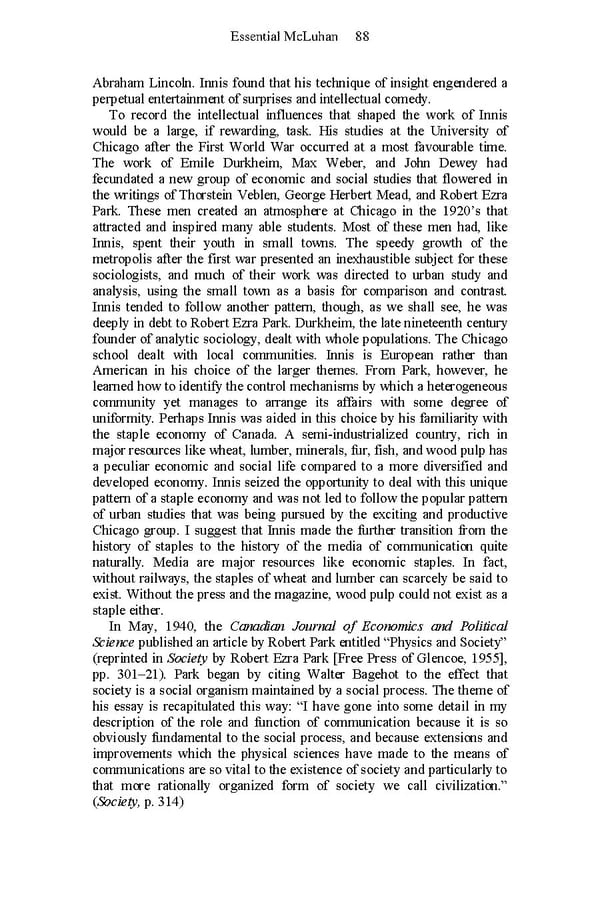Essential McLuhan 88 Abraham Lincoln. Innis found that his technique of insight engendered a perpetual entertainment of surprises and intellectual comedy. To record the intellectual influences that shaped the work of Innis would be a large, if rewarding, task. His studies at the University of Chicago after the First World War occurred at a most favourable time. The work of Emile Durkheim, Max Weber, and John Dewey had fecundated a new group of economic and social studies that flowered in the writings of Thorstein Veblen, George Herbert Mead, and Robert Ezra Park. These men created an atmosphere at Chicago in the 1920’s that attracted and inspired many able students. Most of these men had, like Innis, spent their youth in small towns. The speedy growth of the metropolis after the first war presented an inexhaustible subject for these sociologists, and much of their work was directed to urban study and analysis, using the small town as a basis for comparison and contrast. Innis tended to follow another pattern, though, as we shall see, he was deeply in debt to Robert Ezra Park. Durkheim, the late nineteenth century founder of analytic sociology, dealt with whole populations. The Chicago school dealt with local communities. Innis is European rather than American in his choice of the larger themes. From Park, however, he learned how to identify the control mechanisms by which a heterogeneous community yet manages to arrange its affairs with some degree of uniformity. Perhaps Innis was aided in this choice by his familiarity with the staple economy of Canada. A semi-industrialized country, rich in major resources like wheat, lumber, minerals, fur, fish, and wood pulp has a peculiar economic and social life compared to a more diversified and developed economy. Innis seized the opportunity to deal with this unique pattern of a staple economy and was not led to follow the popular pattern of urban studies that was being pursued by the exciting and productive Chicago group. I suggest that Innis made the further transition from the history of staples to the history of the media of communication quite naturally. Media are major resources like economic staples. In fact, without railways, the staples of wheat and lumber can scarcely be said to exist. Without the press and the magazine, wood pulp could not exist as a staple either. In May, 1940, the Canadian Journal of Economics and Political Science published an article by Robert Park entitled “Physics and Society” (reprinted in Society by Robert Ezra Park [Free Press of Glencoe, 1955], pp. 301–21). Park began by citing Walter Bagehot to the effect that society is a social organism maintained by a social process. The theme of his essay is recapitulated this way: “I have gone into some detail in my description of the role and function of communication because it is so obviously fundamental to the social process, and because extensions and improvements which the physical sciences have made to the means of communications are so vital to the existence of society and particularly to that more rationally organized form of society we call civilization.” (Society, p. 314)
 Essential McLuhan Page 94 Page 96
Essential McLuhan Page 94 Page 96